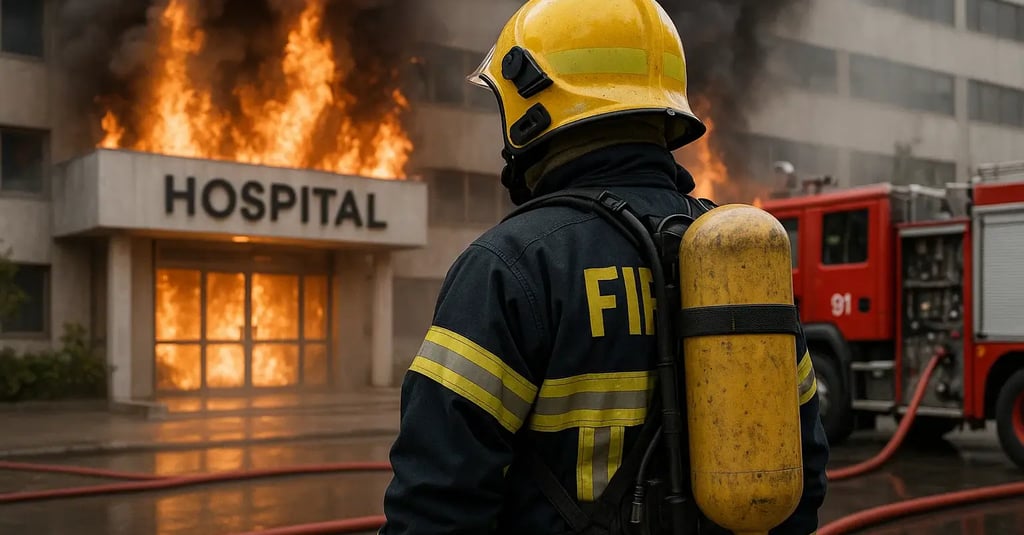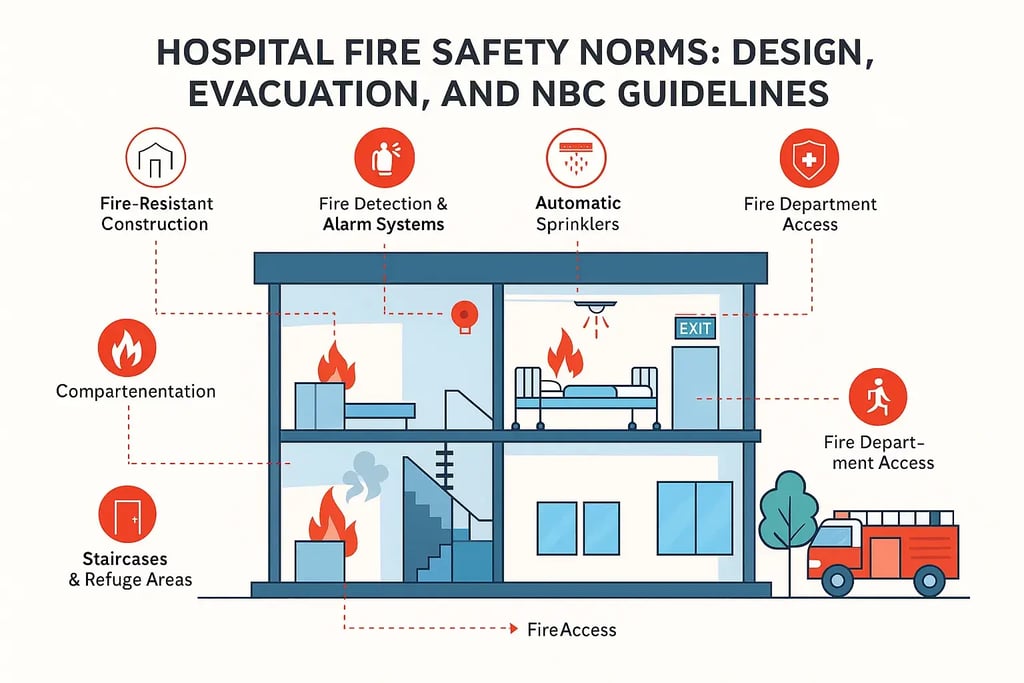Hospital Fire Safety Norms: Design, Evacuation, and NBC Guidelines
Learn how to ensure fire safety in hospitals with proper architectural planning. Explore NBC 2016 norms, NABH fire compliance, global standards, and smart evacuation design strategies.
7/26/20253 min read


Introduction: Why Fire Safety is Critical in Hospital Design
Hospitals are complex and high-risk environments. The presence of vulnerable patients, flammable materials, life-saving equipment, and 24/7 operations means that fire safety in hospitals is not just a regulatory requirement — it's a matter of life and death.
A well-designed hospital must incorporate robust fire safety norms right from the planning stage. At Archora, we believe that compliance with fire safety codes, evacuation planning, and passive/active safety systems should be integrated into the architecture itself.
1. Fire Zoning and Compartmentalization: Stopping the Spread
The National Building Code (NBC 2016) mandates fire zoning to contain fire and smoke within designated compartments. This ensures that in case of a fire, damage is limited, and safe evacuation is possible.
Design Recommendations:
Divide the hospital into fire compartments not exceeding 750 m² (as per NBC guidelines)
Use fire-rated walls and doors (minimum 2-hour rating) to separate high-risk areas like ICUs, labs, and electrical rooms
Design smoke-proof lobbies near staircases and lifts
Why it Matters:
Without compartmentalization, fire and toxic smoke can spread rapidly across floors and departments, putting lives at risk.
2. Safe and Accessible Escape Routes
Evacuation in hospitals is complex due to immobile patients, reliance on equipment, and the need for orderly movement. Hence, multiple, protected, and clearly marked escape routes are essential.
NBC and NABH Guidelines:
Minimum 2 staircases for every hospital wing; one must be fire escape-rated
No dead-end corridors longer than 6 meters
Corridors must be minimum 2.4 meters wide
Emergency exits should open outwards and be clearly signposted
Global Best Practices (NFPA 101):
Include horizontal evacuation areas before vertical movement
Design Area of Refuge spaces for non-ambulatory patients
3. Fire Detection, Alarms, and Suppression Systems
Early detection and suppression are vital. Hospitals must implement layered systems of sensors, sprinklers, extinguishers, and alarms to quickly contain fire incidents.
Key Elements to Include:
Automatic fire detection system integrated with nurse stations and security
Sprinkler systems in basements, electrical rooms, and storages
Hydrant and hose reel systems on every floor with access within 30 meters
Manual call points and PA announcement systems for alarm communication
Coordination with Architecture:
MEP services must be coordinated with the architecture to avoid blocked vents, unprotected shafts, or inaccessible panels.
4. Material Selection and Interior Planning
Fire safety isn't only about exits and alarms — the choice of materials plays a huge role in slowing down the fire and smoke spread.
Design Tips:
Use low-smoke, zero-halogen wiring and flame-retardant finishes
Avoid wood-based false ceilings or partitions in critical zones
Install fire dampers in HVAC ducts
Choose non-toxic paint and flooring to reduce harmful emissions in a fire
Global Insight:
NFPA suggests choosing materials based on smoke development index and flame spread index for better safety.
5. Regulatory Compliance and Documentation
Hospital projects must comply with multiple regulatory layers for fire safety, including:
NBC 2016 Part 4: Fire and Life Safety
NABH standards on infrastructure safety
State fire department clearances
Action Points:
Submit drawings for fire NOC during sanction
Obtain Form A and B from local fire authorities
Conduct third-party safety audits before occupancy
At Archora, we design hospitals with pre-approval in mind, reducing chances of rejection and delays.
Conclusion: Design is the First Line of Defense
Fire safety in hospitals isn’t a feature to be added later — it must be embedded in the design DNA. By following NBC norms, using smart zoning strategies, planning seamless evacuations, and ensuring coordination between architecture and MEP, we create hospitals that protect life under the worst conditions.
Want to build a fire-compliant, future-ready healthcare facility? Contact Archora to partner with experts in hospital architecture.
Recommended Reading:



ARCHORA
Where Infrastructure Inspires Healing
Innovate
Inspire
© 2025. All rights reserved.
Create
